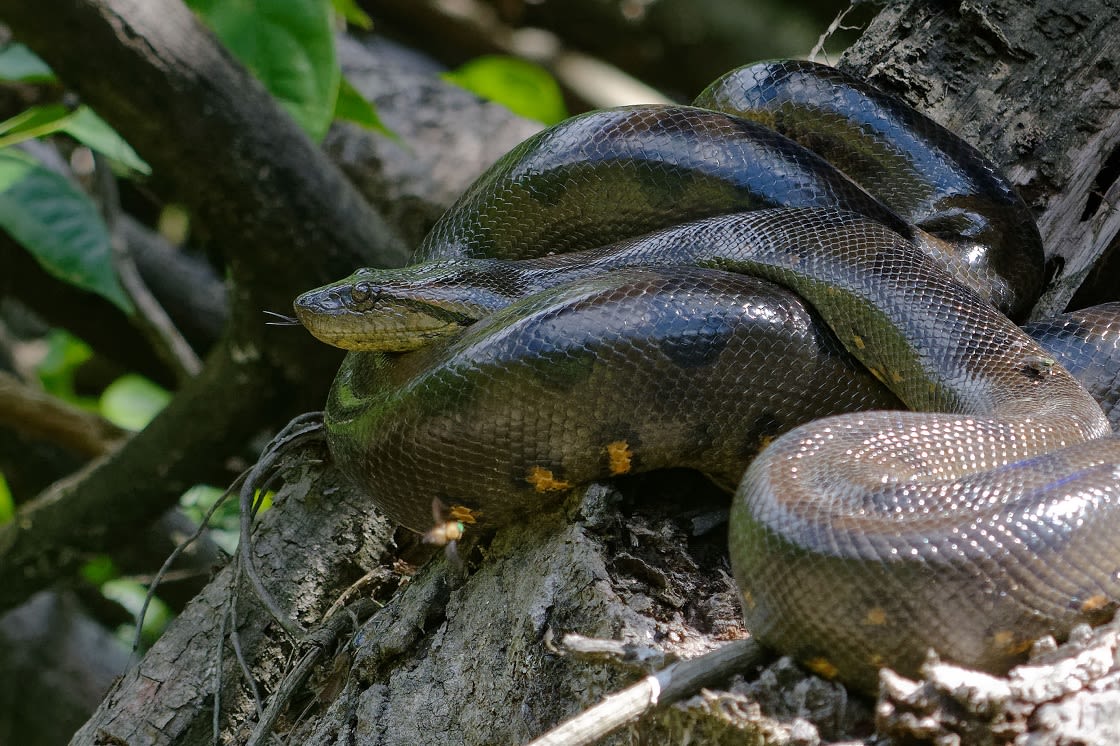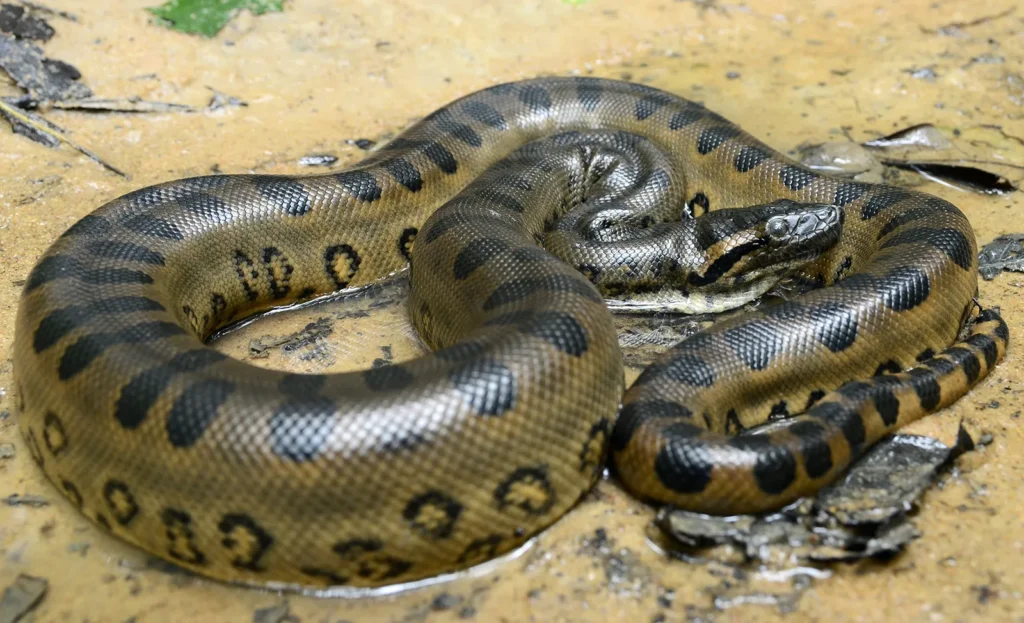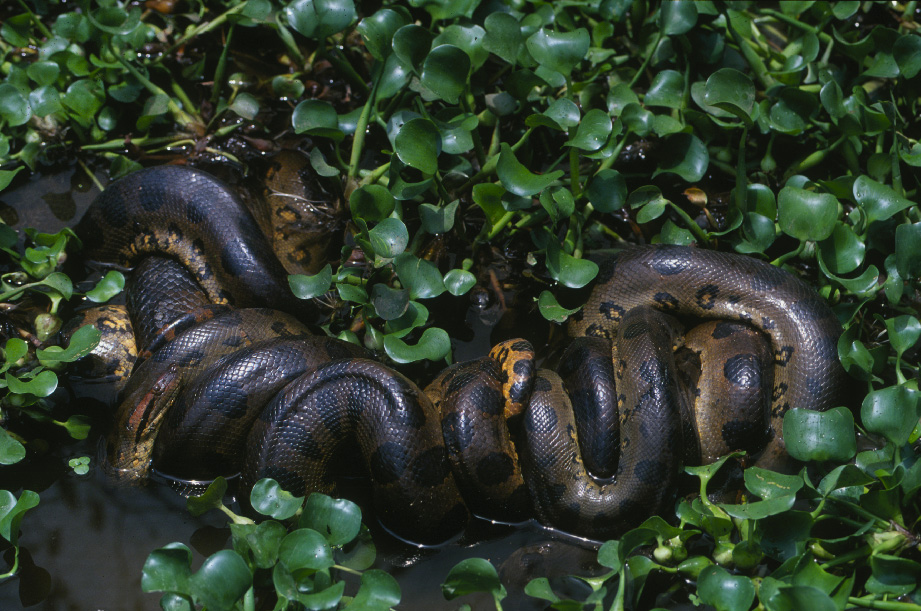“Masters of the Swamp: The True Story of the Green Anaconda”

The green anaconda (Eunectes murinus) is one of the most awe-inspiring creatures in the animal kingdom. Native to the swamps, rivers, and rainforests of South America, it is the heaviest and one of the longest snakes in the world. Mysterious, powerful, and often misunderstood, the green anaconda has captured human imagination for centuries—through indigenous folklore, modern mythology, and even Hollywood films.
This article explores the biology, behavior, habitat, hunting techniques, reproduction, myths, and conservation status of these giant snakes, providing a detailed look at one of the world’s most fascinating reptiles.
🐍 Physical Characteristics
The green anaconda is the largest species in the boa family and arguably the largest snake in the world by weight.
- Length: Typically 15–20 feet (4.5–6 meters), but some females may reach 30 feet (9 meters)—though such reports are rare and often exaggerated.
- Weight: Can exceed 550 pounds (250 kg), making it the heaviest snake on Earth.
- Coloration: Olive-green body with black oval blotches along the back and sides, helping it camouflage in murky waters.
- Head: Narrow with distinctive orange-yellow stripes on either side.
- Eyes and nostrils are positioned on top of the head, ideal for submerged ambush hunting.
Sexual dimorphism is present: females are significantly larger than males, often by two to three times in weight.
🌎 Habitat and Range
Green anacondas are native to South America, primarily in:
- The Amazon and Orinoco river basins
- Countries like Brazil, Venezuela, Colombia, Ecuador, Peru, Bolivia, and Guyana
They thrive in tropical wetlands, slow-moving rivers, flooded grasslands, swamps, and seasonal marshes. Anacondas are semi-aquatic and prefer water environments that provide both cover and prey.
🦎 Behavior and Adaptations
Green anacondas are solitary, non-venomous constrictors. They are primarily nocturnal and spend most of their time in or near water.
Key behaviors and traits:
- Ambush predators: They wait motionless in the water and strike swiftly at passing prey.
- Excellent swimmers: They are agile in water but slower on land due to their bulk.
- Camouflage: Their coloration blends well with vegetation and muddy waters.
- Thermoregulation: They bask in the sun to raise their body temperature after long periods in cold water.
Despite their size, they are non-aggressive toward humans unless provoked. Attacks on humans are extremely rare and mostly exaggerated in media.

🐖 Diet and Hunting
Green anacondas are apex predators, feeding on a wide variety of animals. Their jaws are connected by elastic ligaments, allowing them to swallow prey much larger than their head.
Common prey includes:
- Fish
- Birds
- Capybaras
- Wild pigs
- Deer
- Caimans (small crocodilian reptiles)
- Occasionally other anacondas (cannibalism has been recorded)
Hunting Method:
- Ambush: They lie submerged with only their eyes and nostrils above water.
- Strike: Once the prey is within reach, they lunge, grab it with sharp, backward-curved teeth.
- Constriction: They wrap around the prey and squeeze until it suffocates.
- Swallowing: The prey is consumed whole, head first.
After a large meal, an anaconda may not need to eat for weeks or even months.
🐍 Reproduction and Lifecycle
Anacondas are ovoviviparous, meaning they give birth to live young rather than laying eggs.
Mating:
- Occurs during the rainy season (April–May).
- Several males (up to a dozen) may coil around a single large female in a “breeding ball.”
- Males use spurs near their cloaca to stimulate the female.
Gestation and Birth:
- Gestation lasts 6–7 months.
- A female may give birth to 20–40 live young, each about 2 feet (60 cm) long.
- Newborns are independent immediately and begin hunting small prey.
Cannibalism can occur—females have been known to eat smaller males after mating.
🧪 Scientific Importance and Myths
Despite centuries of fascination, anacondas remain mysterious due to their reclusive habits in remote, swampy habitats.
Myths and Misconceptions:
- Exaggerated size: While 30-foot legends persist, verified specimens rarely exceed 20–22 feet.
- Human-eaters: Highly rare; no confirmed cases of a green anaconda killing and consuming a human in the wild.
- Aggressive monsters: In reality, they avoid humans and prefer to escape rather than fight.
Documentaries and fiction often portray them as monstrous, but scientific studies continue to reveal their true ecological importance and intelligence.
🌱 Conservation Status
- IUCN Red List Status: Not currently evaluated as endangered, but their populations are considered vulnerable in certain areas.
- Threats:
- Habitat destruction (deforestation, agriculture)
- Pollution of water systems
- Hunting for skin and illegal pet trade
- Fear-based killings due to myths
Green anacondas play a critical role in controlling prey populations, maintaining balance in their ecosystems.
🧭 Human-Anaconda Interactions
In Indigenous Amazonian cultures, anacondas are symbols of strength, fertility, and transformation. Some tribes view them as sacred river spirits.
Ecotourism and conservation initiatives are helping shift public perception from fear to respect. Researchers continue to study their behavior, ecology, and genetic diversity.

🧠 Conclusion
The green anaconda is much more than just a giant snake—it’s a biological marvel, a cultural icon, and a keystone species of South America’s aquatic ecosystems. Misunderstood for generations, this serpent is finally being appreciated not as a villain but as an evolutionary success story, perfectly adapted to its watery world.
If we continue to protect its habitat and dispel the myths that surround it, the green anaconda will remain a powerful reminder of the mystery and majesty of Earth’s wild places.”Masters of the Swamp: The True Story of the Green Anaconda”




